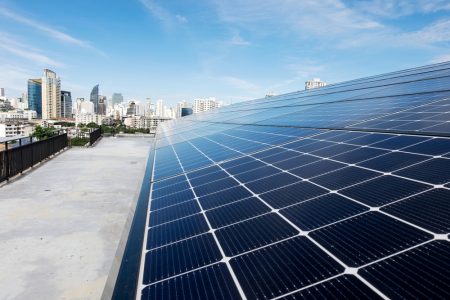Is It Worth Going Solar? Decreasing Solar Prices Have Naysayers Making Noise
 Since the early 2000’s, we’ve seen retail electricity prices steadily rise, about 1.5% per year since 2005. This can be justified due to several different reasons—rising costs of power production, power grid updates and maintenance, transmission and distribution as well as the continued price increase of natural gas. Many solar cynics believe that renewable resources are making electricity more expensive, but the data suggests that this is just not true. Going solar makes sense in a market where we see solar+ storage prices drastically decreasing.
Since the early 2000’s, we’ve seen retail electricity prices steadily rise, about 1.5% per year since 2005. This can be justified due to several different reasons—rising costs of power production, power grid updates and maintenance, transmission and distribution as well as the continued price increase of natural gas. Many solar cynics believe that renewable resources are making electricity more expensive, but the data suggests that this is just not true. Going solar makes sense in a market where we see solar+ storage prices drastically decreasing.
The Impact of Renewable Resources
A study conducted by the US Department of Energy’s Lawrence Berkeley National Laboratory (LBNL), looked at the impact of renewable resources on power prices, realizing that our power markets are ever-evolving. They found that overall, wind and solar production have both reduced the annual average wholesale prices of electricity. The greatest effect occurred from 2008 through 2012 as the shale boom developed and gas prices plummeted after the ‘08 recession. From 2012 through 2017 this shifted, and we see wind and solar production booming. LBNL then predicts from 2017 through 2022 wholesale costs are projected to increase.
As the prices of electricity in the US slowly rise, natural gas prices used for electric generation continue to fall at an average rate of 8.4% per year since 2006. The study conducted by LBNL shows that where wind and solar penetrations were greatest— California Independent System Operator (CAISO) and Midcontinent Independent System Operator (MISO) for example—we see the biggest decline in prices due to the renewable resources being the greatest in these areas.
Within these particular areas, the markets showed fluctuating reasons for these price declines from renewable resources. CAISO leads the market for solar power, representing a third of all solar power installed across the nation and they also hold the greatest effect. Heavy wind and solar production also contributed to negative pricing moments between 2015 and 2017.
Could Electricity Prices Fall in the Future?
Highly unlikely. The price of natural gas has fallen significantly in recent years, but many expect these prices to rise once America’s gas supply is introduced to international markets. Another contributing factor—climate change. With the rapid fluctuations in extreme temperatures, this drives up the need for electricity as more is needed for heating or cooling. The US Energy Information Administration (EIA), also predicts electricity prices to increase both in short– and long-term instances, regardless of the decreasing prices of wind and solar energy.
Do you have an interest in lowering your energy costs or upgrading your facility to keep up with efficiency and output? Turn to the experts at Intersect Energy! We provide turnkey solutions to our customers, offering assessment, design, financing, installation and management services. Decrease your electricity prices by increasing your solar energy consumption with Intersect! To keep up with all the latest news in renewable energy, make sure to follow us on LinkedIn.
 For the last five years, homeowners and commercial business owners have enjoyed the benefits of the solar investment tax credit. This tax credit (ITC) allows you to deduct 30% of the cost of installing a solar energy system to your property from your federal taxes. This saves the shopper on average about $9,000. Now, House Democrats have drafted a clean energy package to extend this tax credit to wind and energy storage industries as well as add another five-year extension. Not only could this advanced tax credit reduce emissions, it could also create thousands of jobs and boost the economy. Enjoying bi-partisan support in the House, this development makes clean energy accessible and affordable for everyday Americans.
For the last five years, homeowners and commercial business owners have enjoyed the benefits of the solar investment tax credit. This tax credit (ITC) allows you to deduct 30% of the cost of installing a solar energy system to your property from your federal taxes. This saves the shopper on average about $9,000. Now, House Democrats have drafted a clean energy package to extend this tax credit to wind and energy storage industries as well as add another five-year extension. Not only could this advanced tax credit reduce emissions, it could also create thousands of jobs and boost the economy. Enjoying bi-partisan support in the House, this development makes clean energy accessible and affordable for everyday Americans. Our biggest source of energy, the Sun emits enough energy to completely satisfy the entire human demand for energy for over two hours! In the past few years, we’ve seen a steady rise in the deployment of large-scale solar power operations, with installations over the next few years set to reach a record high. New advancements in technology have increased these record high numbers, making solar paneling more efficient while driving down costs. While there have been a few setbacks in the quest to go solar, recent research conducted by
Our biggest source of energy, the Sun emits enough energy to completely satisfy the entire human demand for energy for over two hours! In the past few years, we’ve seen a steady rise in the deployment of large-scale solar power operations, with installations over the next few years set to reach a record high. New advancements in technology have increased these record high numbers, making solar paneling more efficient while driving down costs. While there have been a few setbacks in the quest to go solar, recent research conducted by